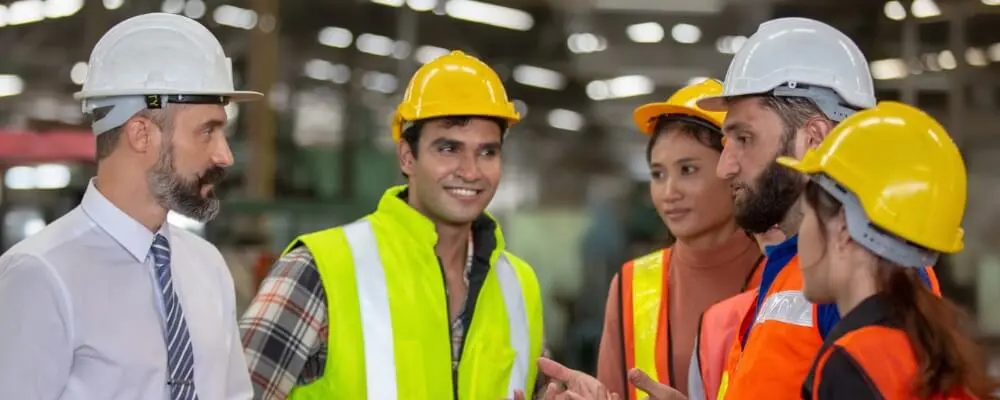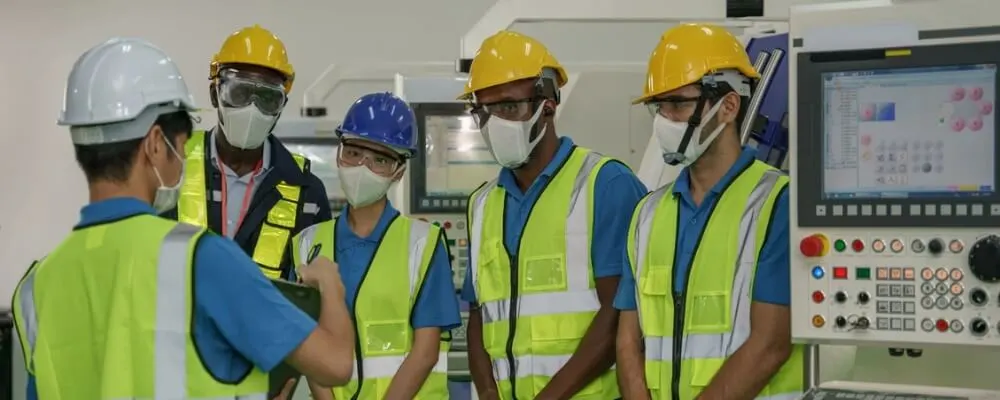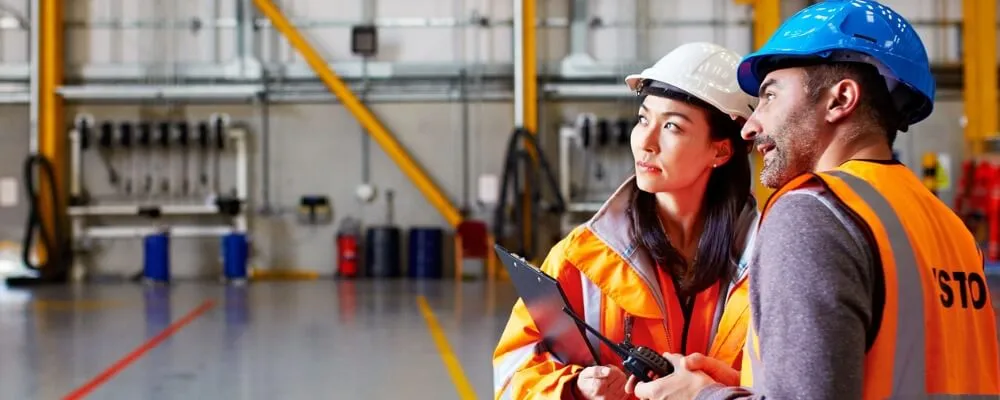In today’s fast-paced industrial world, the emphasis on workplace safety has never been more pronounced. While machinery gets more advanced and processes more complex, the well-being of the human element—our workforce—remains paramount. Enter the Safety Representative: a pivotal role often operating behind the scenes but integral to any organization’s smooth and safe functioning.
This blog delves deep into the world of the Safety Representative, shedding light on their critical roles, responsibilities, and the undeniable impact they have on every facet of a company’s operations. Join us as we unravel the intricacies of this role and understand why a Safety Representative is the unsung hero of workplace safety.
What’s a Safety Representative?
A Safety Representative is an individual appointed or selected by workers in an organization to represent their interests and concerns in matters related to workplace safety and health. Their primary role is to act as a bridge between the workforce and management, ensuring that safety standards are upheld and that potential hazards are addressed promptly.
Safety Representatives play a crucial role in fostering a culture of safety within an organization. They conduct regular safety inspections, provide feedback on safety policies, and facilitate training sessions to educate employees about safe work practices. Safety Representatives collaborate with management in workplace incidents to investigate the causes and implement preventive measures. Their involvement helps in adhering to regulatory standards, building trust, and promoting open communication about safety concerns within the workplace.

Importance Of Safety Representative
The role of a Safety Representative is crucial in any organization, and its importance can be understood through multiple dimensions:
- Protection of Employees: At the forefront of a Safety Representative’s responsibilities is the protection of employees. They ensure the workplace is safe from hazards, reducing the risk of accidents, injuries, and illnesses. A safe workforce is a healthy and productive one.
- Legal and Regulatory Compliance: Safety Representatives ensure that the organization adheres to local, state, and national safety regulations. Non-compliance can result in severe penalties, legal consequences, and company reputation damage. By staying updated with current safety standards and regulations, the Safety Representative helps the organization avoid these pitfalls.
- Financial Benefits: Accidents and injuries can result in high medical costs, compensation claims, and increased insurance premiums. A proactive approach to safety, led by the Safety Representative, can prevent these unforeseen expenses, making it a financially sound investment.
- Promoting a Positive Work Culture: A strong safety culture demonstrates to employees that their well-being is a priority. This boosts morale, increases job satisfaction, and improves employee retention rates. The presence of a Safety Representative signifies that the organization is committed to the welfare of its staff.
- Continuous Improvement: Safety Representatives don’t just maintain current safety standards; they seek to improve them. The organization is always at the forefront of best safety practices by continuously assessing and revising safety protocols and training.
- Informed Decision-Making: With their specialized knowledge, Safety Representatives provide valuable insights during decision-making processes. Whether introducing new machinery, altering work processes, or renovating workplace infrastructure, their input ensures that safety is never compromised.
- Emergency Preparedness: In the face of unexpected events like fires, natural disasters, or chemical spills, a well-prepared organization can minimize damage and protect its employees. Safety Representatives are key in creating, updating, and implementing emergency response plans.
- Stakeholder Confidence: For stakeholders, including investors, partners, and customers, knowing that an organization prioritizes safety can be a significant positive factor. It reflects well on the company’s values, operational efficiency, and overall reputation.
- Facilitates Communication: Safety Representatives act as a bridge between the workforce and management on safety-related concerns. This two-way communication ensures that safety concerns from the ground are escalated and top-down safety directives are effectively communicated and implemented.
In essence, the importance of a Safety Representative goes beyond just compliance and risk mitigation. They play a central role in shaping an organization’s culture, reputation, and overall success.

Roles and Responsibilities of a Safety Representative:
A Safety Representative is pivotal in ensuring the workplace is safe and conducive for all employees. Their roles and responsibilities often encompass various tasks focused on maintaining health and safety standards. Here’s an overview:
1. Liaison between Employees and Management
The Safety Representative serves as the key intermediary in the flow of safety information between the employees and the management. This position holds a unique stance as it bridges the potential communication gap between the two.
By being available to both sides, the Safety Representative ensures that employees have a voice when they encounter safety concerns and that management is promptly informed about them. Simultaneously, they relay management’s safety directives and policies to the employees, ensuring everyone is on the same page regarding workplace safety.
2. Conducting Safety Inspections
An essential duty of a Safety Representative is to conduct regular safety inspections within the workplace. This is not just a cursory glance but a thorough review, looking for any risks or potential hazards that could harm the employees or disrupt operations. This proactive approach helps anticipate and mitigate risks before they lead to accidents.
Moreover, these inspections ensure that the organization adheres to set safety regulations, thus avoiding potential legal complications.
3. Investigating Incidents
When accidents or dangerous events occur, the Safety Representative analyzes what happened. This holistic investigation considers every factor and condition that might have contributed to the incident.
By understanding the root cause, the Representative can suggest and help implement measures to prevent similar incidents. This process is not about placing blame but about understanding and rectification.
4. Safety Training and Awareness
A proactive approach to safety is always more effective than a reactive one. Recognizing this, the Safety Representative organizes and sometimes personally conducts employee training sessions. These sessions range from properly using safety equipment to emergency evacuation procedures.
Regular safety drills and workshops ensure all employees have the knowledge and skills to protect themselves and their colleagues.

5. Feedback on Safety Policies
As someone constantly interacting with the management and the employees, the Safety Representative is in an ideal position to evaluate the efficacy of existing safety policies. If certain procedures aren’t working or could be improved, the Representative provides feedback and actionable suggestions to management. This iterative process ensures that safety policies evolve in tandem with the changing dynamics and needs of the workplace.
6. Reporting
Documentation is a crucial aspect of the Safety Representative’s role. Keeping an accurate record of safety concerns raised, inspections conducted, incidents that occurred, and corrective measures implemented helps track the organization’s safety trajectory.
These reports not only provide a historical record but can be used to identify patterns or recurring issues. They ensure transparency and accountability, showing that every concern is taken seriously and addressed promptly and that lessons are learned from every incident.
7. Staying Updated
In the ever-evolving world of workplace safety, being complacent is not an option. A Safety Representative is responsible for being well-informed about the latest safety legislation and industry best practices. This continuous learning ensures that the organization remains compliant with existing regulations and is prepared for upcoming changes.
By staying updated, the Representative helps the organization avoid potential legal pitfalls and ensures employees benefit from the latest safety innovations and standards.
8. Promoting Safety Culture
Beyond rules and regulations, true safety in the workplace is built on a foundation of culture. A Safety Representative plays a pivotal role in fostering an environment where safety is not just a policy but a shared value. By promoting this culture, the Representative ensures that safety becomes an integral part of the organization’s ethos.
Encouraging employees to voice their concerns and suggestions creates a collaborative atmosphere where everyone feels responsible for each other’s well-being.

9. Attending Safety Meetings
Active participation in safety committee meetings is essential for a Safety Representative. These meetings offer a platform to discuss ongoing safety concerns, brainstorm solutions, and strategize for the future. Collaboration with other committee members, who bring diverse perspectives, ensures that safety plans are holistic and consider all potential challenges.
10. Consultation
While a Safety Representative is an expert in their right, there are times when external expertise is required. Engaging with external safety specialists or regulatory bodies ensures the organization gets the best advice on complex safety matters.
Whether seeking clarification on a specific regulation or understanding the intricacies of a new safety technique, this consultation ensures that the organization’s safety standards are top-notch.
11. Emergency Response
Anticipating emergencies and preparing for them is a crucial aspect of workplace safety. The Safety Representative is instrumental in developing comprehensive emergency response plans. Employees should be well-drilled in the following protocols for fires and natural disasters.
The Representative ensures that these plans are in place and regularly updated and practiced, guaranteeing that in the face of an emergency, panic does not ensue and safety procedures are followed seamlessly.
12. Resource Management
Safety protocols are one thing; having the tools and resources to implement them is another. The Safety Representative oversees the management of vital safety resources. Whether it’s ensuring that first aid kits are fully stocked or that safety equipment is maintained in pristine condition, the Representative ensures that these resources are readily available.
By effectively managing these resources, they guarantee that if and when they are needed, they can be accessed without delay, potentially saving lives or preventing severe injuries.
Conclusion
Navigating the multifaceted realm of workplace safety, the Safety Representative stands as a beacon of protection, guidance, and assurance for employers and employees. Their roles, from proactive hazard identification to fostering a robust safety culture, underscore the holistic approach required to maintain a secure working environment.
As we’ve explored, their responsibilities are identifying risks, bridging the communication gap between the workforce and management, and ensuring that safety is not just a policy but a practiced value. In understanding the intricacies of the Safety Representative’s role, we recognize the importance of their contribution to an organization’s overall health and success. Every safe day at work is a testament to their relentless dedication and commitment.

